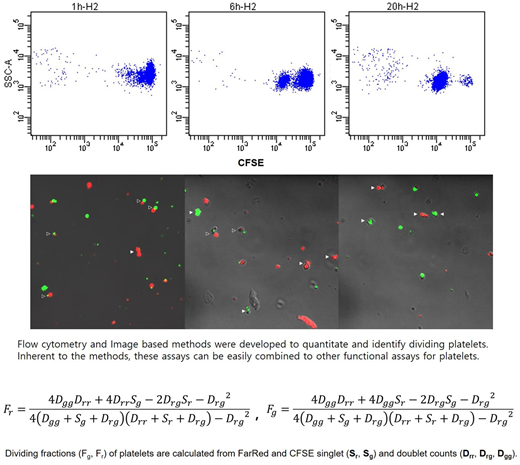Abstract
Background: Unlike dividing cells, platelets are usually regarded as unproductive in that they are anuclear fragments of megakaryocyte and incapable of the canonical cell cycle. However, recent evidence showed that platelets could form progeny or at least undergo fission. The observation indicated the existence of a non-hematopoietic mechanism to determine platelet count in peripheral blood. The assessing the kinetic aspects of platelet division is not easy because automated cell counters often give equivocal results after culture not supporting those previous findings. Manual chamber counting is impractical because of the difficulty in differentiating singlets from any small sized clumps.
Objective: We examined platelet division under in-vitro culture conditions to assess how many platelets and how fast they divide.
Methods: We devised a method to track platelet division based on flow cytometry and fluorescent microscopic image. Briefly, buffered human platelet suspension was prepared and stained with cell tracking dyes followed by sorting and resuspension in cell culture medium and incubation. Platelet division was assessed quantitatively by observing a decrease in fluorescent intensity by flow cytometry after culture in a liquid medium or counting the number of single colored platelet doublets after culture in hydrogel medium.
Results: After 6-hour culture of CFSE labelled platelet in M199 medium, we observed the appearance of a separate cluster of platelets with reduced CFSE intensity adjacent to the original platelet cluster, as is the typical finding of CFSE dilution assay for lymphocyte proliferation. We continued the culture for 20 hours. The division fraction of strongly labeled platelets was 48.7 % (range: 27.5 - 70.4) after 6 hours and 85.6 % (79.1 - 92.0) after 20 hours. For weakly labelled platelets, the division fraction after 6 hours was 35.0 % (24.6 - 43.4) and 75.5 % (34.5 - 97.0) after 20 hours. The division fractions at the two time points were much higher than expected and the effect of external stimuli such as shearing force exposure during the sorting procedure was to be considered. In another assay, we divided platelet suspension into two and stained with labelling dyes of different colors (CFSE and FarRed). The two fractions were mixed and cultured in hydrogel medium. At the beginning of the culture and after 6 hours, we counted platelet singlets and doublets in ten randomly selected fields of con focal microscopy. Single colored doublets can form both by division and contact. Those with two colors can form only by contact. The count of single- and two-colored doublets can be estimated by binary probability prediction if the platelets don't divide. Initially, the doublet counts follow the binary probability prediction (P: 0.65 - 0.88), but after 6 hours, single colored doublets were observed more frequently than two colored doublets (P<0.01, in the order of 10-6). The division was suppressed by treatment with taxol (P =0.26), nocodazole (P=0.38), and cytochalasin D (P=0.61). From the counted numbers of doublets and singlets of the two colors, we could derive a formula for the platelet division fraction. The division fraction of FarRed stained platelets were 8.3 % (95% CI: 2.2 - 14.4), and that of the CFSE stained platelets were 11.9 % (5.4 - 18.4).
Conclusion: We introduce novel methods to assess platelet division credibly in culture conditions which can be easily combined with functional studies.
No relevant conflicts of interest to declare.
Author notes
Asterisk with author names denotes non-ASH members.


This feature is available to Subscribers Only
Sign In or Create an Account Close Modal